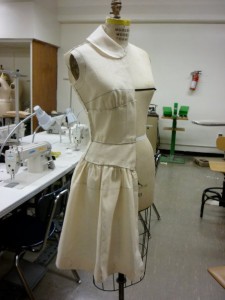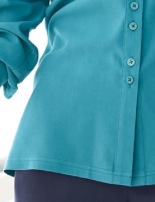The manufacturing process behind Patra’s timeless pure silk shirt
The perfect blouse
Like many things in the world of fashion, behind a high-quality end product is an intricate design and manufacturing process. Blouse manufacture is a prime example of this – a fascinating process that takes a lot of time and preparation, but if done well can produce wonderful results.
Here we look at the manufacturing of blouses – outlining the main features of our popular Fuji Silk Shirt and explaining what makes this high quality blouse so special.
There is a lot that goes into making the perfect blouse. Here we’ve used our expertise to guide you through every step of the process.
Imagine the ideal shirt: perfect fit, incredibly comfortable, amazing fabric and beautiful design. At Patra we aim to always achieve these goals – we want everyone who wears our blouses to feel fantastic in them. Our manufacturing process, developed over fifty years with our chosen manufacturers, contributes significantly to achieving these goal’s and a long lasting quality that’s second to none.
The basics of blouse design
Patra clothing is about comfort and classic style in natural fabrics with special emphasis placed on the design process to achieve these objectives – side vents and easy to wear cuts.
The design team starts this process with a digitally reproduced black and white drawings of the blouse that details the necessary dimensions, tailoring guidance through to details such as seams and stitching design – this is called a fashion flat. It’s at this stage past customer feedback and ease of production features are incorporated, important elements to ensure final garment quality together with ethical production. This design is complied with details of the fabric needed, technical sketches and colour and pattern specifications into a technical pack. This pack is sent to the manufacturer and is essential for reproducing the blouse to the designer’s exact specifications.
If the garment is to form a new product line or has a particularly novel design or cut the technical pack may be followed by a Toile sample. This is a sample made in a similar fabric or calico, often remade several times until we get it right and send it to the manufacturer.
First samples
 Silk is notoriously difficult to work with and the best silk garment manufacturers are found in the Far East of China, where silk originates from. It is important to us to select a factory that meets our high quality expectations in an ethical manner.
Silk is notoriously difficult to work with and the best silk garment manufacturers are found in the Far East of China, where silk originates from. It is important to us to select a factory that meets our high quality expectations in an ethical manner.
The manufacturer begins by producing a prototype, known as a fit or first sample. This is when we see our design come to life.
Once we receive this back we produce feedback and suggest corrections until we are happy. This may take several iterations, and once we are satisfied with the sample the final production ‘paper’ patterns are produced.
Pattern pieces
 Usually fabric is prepared by pre-shrinking and pressing, however our Fuji Silk shirt has a peach finish, giving it its beautiful matt texture. This is produced by a special chemical wash that essentially abrades the fabric slightly causing it to matt. The result is soft and incredibly comfortable next to the skin.
Usually fabric is prepared by pre-shrinking and pressing, however our Fuji Silk shirt has a peach finish, giving it its beautiful matt texture. This is produced by a special chemical wash that essentially abrades the fabric slightly causing it to matt. The result is soft and incredibly comfortable next to the skin.
The pattern pieces are laid on the fabric in the most economical way possible, to minimise waste. The layout also needs to take into account the grain and width of the fabric. And in the case of our silks, the pieces are laid out so the sheen of the fabric goes the same way over the whole garment.
Production
Once the pattern is cut it moves to production. Only the best seamstresses get to work with silk. Each one is allocated a specific garment section and particular attention is paid to the sewing equipment used – the sharp fine needles and the special silk pins.
Silk is a ‘slippery’ fabric extremely difficult to handle during the cutting and garment manufacturing process. In the case of our Fuji silk shirt its matt finish helps reduce movement during cutting – nevertheless no more than five shirts are cut at the same time with extremely sharp scissors – no automation or mechanical cutting saws are used. To aid cutting and also garment consistency silk fabric will typically be unrolled and piled on the cutting room table for at least 24 hours before cutting to allow the fabric to relax.
Finishing
 Extra care is taken to ensure the joining threads won’t shrink and that they match the fabric colour exactly. At Patra we also detail our silk shirt with top-stitching – so thread and its tension is even more critical.
Extra care is taken to ensure the joining threads won’t shrink and that they match the fabric colour exactly. At Patra we also detail our silk shirt with top-stitching – so thread and its tension is even more critical.
The finishing touches focus on the highly visible areas such as:
- Buttons – exact matching button holes with button positions and adding any detailed finishes to the button holes themselves.
- Interlining – making sure the correct weight is used, which is especially important for silk to avoid distortion.
- Cuff and collar inserts – adding that extra high-quality touch that a long-lasting blouse needs in order to stay looking its best.

Our timeless silk blouse in Cream
Long lasting quality and softness
The final step in the process is quality assurance. Each garment is inspected and if approved, it is repressed and packed into its sales packaging with a layer of fine tissue paper to further protect the garment.
Every time you put your Fuji Silk Shirt on, imagine all the time and effort that has been invested in designing and manufacturing it – but quality is always worth the wait.
Our philosophy will always be the same – to create beautiful and comfortable clothes that reflect the best of you and carry on doing so for years to come.


